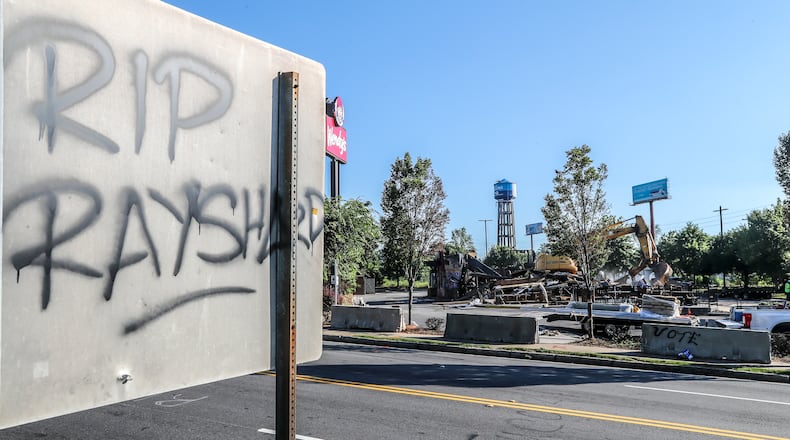More than year after Secoriea Turner’s murder, worrisome questions continue to surface about the details surrounding her death.
A shaken and fearful city, still wracked by an epidemic of gun violence, deserves answers – and reassurances – that the events that occurred during a heated summer of protests and crime will never happen again.
Secoriea, just 8 years old, was killed on July 4, 2020, while riding in a car with her family south of downtown. Their vehicle was fired upon after entering a city block that was, in effect, under the dominion of a band of armed people who had seized control of who could enter or leave.
This de facto border checkpoint was near a fast-food restaurant where Rayshard Brooks was shot and killed by an Atlanta police officer less than a month earlier.
Brooks’ death raised questions about the use of force by police and led to protests. Many of those demonstrations were peaceful; others were not. Arsonists set fire to the Wendy’s where Brooks was killed, burning it to the ground as cameras rolled.
Arrest warrants recently issued by the GBI in connection with Secoriea’s death asserted that gang members were central to the events that resulted in the child’s murder. And they plainly allege that the city had ceded control of the street corner.
“The area surrounding the intersection of Pryor Road and University Avenue was seized from the authority of the City of Atlanta in response to a Bloods criminal street gang uprising in reference to the shooting death of Rayshard Brooks,” an arrest affidavit reads. “Atlanta Police Department officers were not allowed into the area and the Bloods gang and its associates operated the area as an ‘autonomous zone’ in which the sovereign authority of the City and State were not recognized, and the Bloods gang exerted all control.”
And violent control it was.
On the evening of Secoriea’s death, “multiple armed parties pointed rifles” at a MARTA bus that pulled up to the barricade. And only a few minutes before the fatal shots were fired, another vehicle was turned away at gunpoint, according to the warrants.
If all that sounds worrisome, it should.
Even during a violent summer marked by protests, and a still-ongoing reckoning around the role of race and policing in American society, the GBI’s matter-of-fact description of the city’s surrendering a block to a gang is shocking – and unacceptable.
It is – or should be – a fundamental job of even the most-limited of governments to protect citizens from lawlessness. That is a reasonable expectation.
But that didn’t happen last summer on that Atlanta street corner. And a child innocently passing through was shot to death during the period when lawful control was ceded to the lawless.
At this fraught point in American history, it’s important to note some of the relevant context here that still swirls around us.
Gatherings of heavily armed people are not uncommon on American streets in recent years.
Self-described “patriots” armed with AR15-style semiautomatic rifles have roamed the grounds of the Gold Dome not far from where Secoriea was killed. At least one person has tested the limits of state and federal gun laws by walking into Hartsfield-Jackson International Airport with a similar long weapon.
And few will soon forget the assault on the U.S. Capitol – a misguided attempt to overthrow a lawful election. Deaths and injuries resulted from what was a clear attack on democracy.
All of which is to say that America finds itself in a precarious moment, with the threat – or reality – of violence too often looming.
Even against this national backdrop, it is apparent that allowing a corner of Atlanta to be wrested from the oversight of lawful authorities was a grave and costly mistake. At minimum, it shows poor decision-making by city leaders.
We note that this Editorial Board last summer praised then-Atlanta Police Department Chief Erika Shields for showing restraint when earlier protests devolved into destruction downtown. Looting stores, or even torching police cars, is criminal behavior, yes, and worthy of prosecution and punishment. But it is a long way from gang members setting up a checkpoint on city streets and enforcing their way with long guns.
The allegations of gang involvement in the crimes that occurred around a blockaded intersection deserve investigation – and, if warranted, prosecution.
More importantly, Atlantans deserve to know what city officials knew – or didn’t, and why – about the role of gang members in the lawlessness that transpired.
A spokesperson for Atlanta Mayor Keisha Lance Bottoms said last week that neither the mayor “nor any members of her administration, had knowledge of any gang involvement in this case, until she learned about it via media reports.”
Bottoms told The Atlanta Journal-Constitution during a July 2020 Editorial Board meeting that she had wanted the area cleared weeks earlier but was dissuaded by City Councilwoman Joyce Sheperd, who wanted to negotiate with protesters. Those negotiations eventually broke down, and on June 23, 2020, police removed the barricades. Sheperd has declined to comment.
The Atlanta Journal-Constitution asked the mayor’s office to write a guest column for this page, but they declined, citing the ongoing criminal investigation.
That investigation will most likely yield answers as the justice system moves along in its work.
Criminal charges have already been filed in Secoriea’s death and other assaults that reportedly occurred in the would-be “autonomous zone.” More may be forthcoming.
Atlantans, though, still deserve answers about what was allowed to happen.
They deserve to know who knew what – and when.
They deserve to know who chose not to act – and why.
That, after all, will serve as a first step in ensuring this never happens again.
The Editorial Board.
Keep Reading
The Latest
Featured


